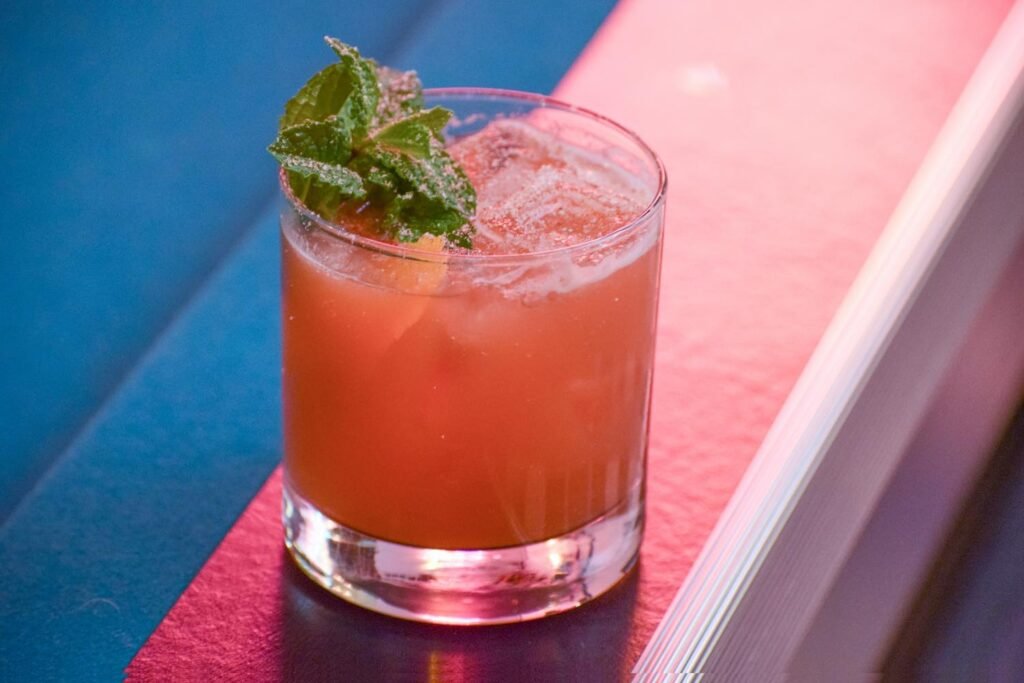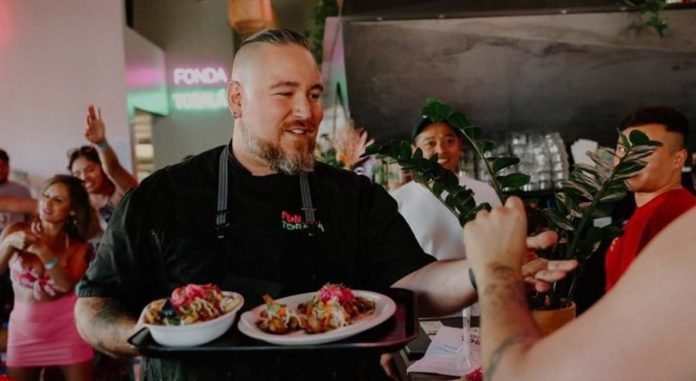The breadth of Chef Manuel Bañuelos’s gastronomical reach is one that is easily astounding.Born in Guadalajara, trained internationally and heading everything from fine dining in London to earning his stripes as making one of the best torta ahogadas in the region when he headed Balam in Lynwood, the food of Bañuelos has been consistently clean and consistently varied in terms of influences—but there is perhaps no purer expression of his food than at Fonda Tobala.
Tobalá, a genuinely familial effort that brings Bañuelos back to the stomachs of Long Beach, he has returned to Mexico full and proper, from those mind-blowing torta ahogadas (this time with a birote from Gusto Bread) to masterfully created cueritos tostadas that remind me of the food stalls in plazas throughout Jalisco—and with him, his wife Fernanda on one side and his mother-in-law Larua on the other leading his front-of-house and kitchen.

“The pandemic hit us all, especially in the food industry, really hard,” Fernanda said, who has stepped away from her day-to-day work to help Bañuelos with Fonda Tobalá. “But it hit Manuel particularly hard and I knew that if he returned to his roots, perhaps we can find a way to lift his spirit.”Fernanda said this as she handed off a plate of three mini-versions of their fried quesadillas: One filled with rajas, another with squash blossoms and quesillo, and a third with huitlacoche.
The first sense is not the aroma of their fillings but the dense earthiness of the corn tortillas they are fried in: Using heirloom corn shipped from Oaxaca, Fernanda notes that part of Bañuelos’s approach to Fonda Tobalá has been a much deeper return to roots than expected: He handles the nixtamalization himself.
“Because of course he does the nixtamal, right?” Fernanda says, chuckling and also noting he hand-mortars his chiles for his saliva-inducing salsa macha as well.This “doing his own nixtamal” means that he soaks—along with his mother-in-law, Laura—the dried corn pulled from the stock in an alkaline solution, allowing the hardened shells that surround each kernel to be removed so that it can then be dried again, and broken down into a powder via a stone mortar. That masa then gets turned into a dough and made into tortillas.

The result? Probably the best tortillas in Long Beach, light blue discs of beautifully earthy, warming bits of Mexico gastronomy.Of course, Bañuelos himself doesn’t mention this off the bat; Fernanda is his cheerleader, with Bañuelos’s humbleness far too strong for him to boast of any such endeavors. And it is somewhat of a full-circle moment for the chef: Many years ago, when I had first met Bañuelos, he had told me that to really grasp Mexican food proper, you have to connect with the women.
“When I was in Oaxaca, the food there changed the way I approached cooking forever,” he told me. “Butchering was left to the men but if you wanted to really know the food, you had to talk to the women; the women ran it all. And they created these things that—what’s the word in English?—that… I want to say ‘complicated’ but it’s more, well, complicated than that. It is very layered. There was so much going on in each dish, but everything had a simplicity, with really local flavors that couldn’t be replicated elsewhere.
“I mean it when I say it: Mexican women have changed the way I approach food forever.”

In this sense, there is a beauty to be said about Bañuelos’s food at this particular moment: It is not only driven by this rediscovering of himself but by the women in his life helping lift an understanding that, for Bañuelos, food makes him a better person.
“It is a bit hard for some to understand,” Fernanda said. “The spirit of a chef is creation, yes, but for Manuel, there’s also the part of connecting with others… And not just family and friends but strangers. And your history. And your heritage. And the places you find yourself.”
That last point is a cool little cog in this all: Yes, you will find those cueritos tostadas and fried quesadillas and torta ahogadas—but you will also find little bit of Bañuelos nodding to the pan-Pacific origins of Rosemallows’s first menu.
Genuinely stellar loco moco tacos with those aforementioned blue corn tortillas, layered with a quail egg and gravy conceived out of the drippings of his barbacoa drippings. (And for those uninitiated in the world of Bañuelos’s food, barbacoa has been a long-time part of his food arsenal, having businesses from Guadalajara to Los Angeles that make it.)
There’s homage toward salmon lomi-lomi, a Hawaiian and Samoan staple of chunks of salmon and tomato, layered in a soy-meets-salsa macha concoction that is—kid you not—only seven bucks since Bañuelos knows how to work a fish market and cuts.This is him letting both his new kitchen owner and his patrons that he is, bluntly put, simply happy to have a kitchen again.

And while you can see Bañuelos flex his fine-dining/prix fixe skills when he does tasting menus—his latest had a genuinely stellar Chilean sea bass with a furikake-meets-pistachio pipián sauce that was otherworldly as well as a ceviche whose hints of vanilla and leche de tigre make you second guess what ceviche can be—and flex his ability to make nods to the origins of his new space, it is his bending and molding and reshaping of the food he grew up on that shines brightest.
Those fried quesadillas? They are masterful creations, where each star—in the case of the rajas, the pasilla pepper; in the others, squash blossom and huitlacoche—shine distinctly as odes to the wonderfully fertile bowl that is Mexico’s topography.
The mayacoba beans that create the first layer of his tostada along with his house-made cueritos—pickled pig skin that is as soft as it is toothsome—create a perfect pair for his Yahualica-grown chile de arbol hot sauce. That last part is important: Many places grow chile de arbol, but chile de Yahualica—as it is referred to in Jalisco—carries with it a special weight: It is not the commercial chile de arbol you see everywhere but the chile that is grown in the bright, red-as-a-rash soil region of Jalisco that is Yahualica. It is brighter, peppery-er, and definitively spicy—and it is a sauce that needs but a few dribbles for the skeptical but a heavier dash for the adventurous when it comes to a tostada that is so masterful, it gave My Dude a moment of pause.

Looking up, smiling in a way that I know is one of reflection and reminiscence, he said, “This reminds me so much of my home [in Jalostotitlán, Jalisco]. This is like my childhood on a plate—the days where we went to the plaza and got something special.”
I know this drives into the personal but it struck me in my emotional center—and as my Samuel and Fernanda’s Manuel went into a conversation in Spanish about those very special moments in the food stalls of plazas, myself reminded of the honor of having been invited a handful of times to those very plazas, I was reminded of a surface level, ubiquitous, even boring note about food: It is, indeed, the great human connector. But perhaps more than that, it is also the great human medicine.
Samuel, for a brief moment, got to take a trip back to his hometown without the weight of everything that comes with those memories and Manuel, bogged down from a pandemic that almost annihilated the hospitality industry, gets to showcase his culture, talent, and love for humans in a way our city should be honored to have. This is food I can eat every day, happily—and if you decide to step into Rosemallows, with the privilege of being served by Fernanda with food from Manuel and Laura, I hope you can sense that fulfillment as well.
Fonda Tobalá is inside Rosemallows in DTLB at 255 Long Beach Blvd. Dinner service is Wednesdays and Thursdays from 5PM to 10PM and Fridays and Saturdays from 6PM to midnight. Brunch is served on Sundays from 11AM to 4PM.


